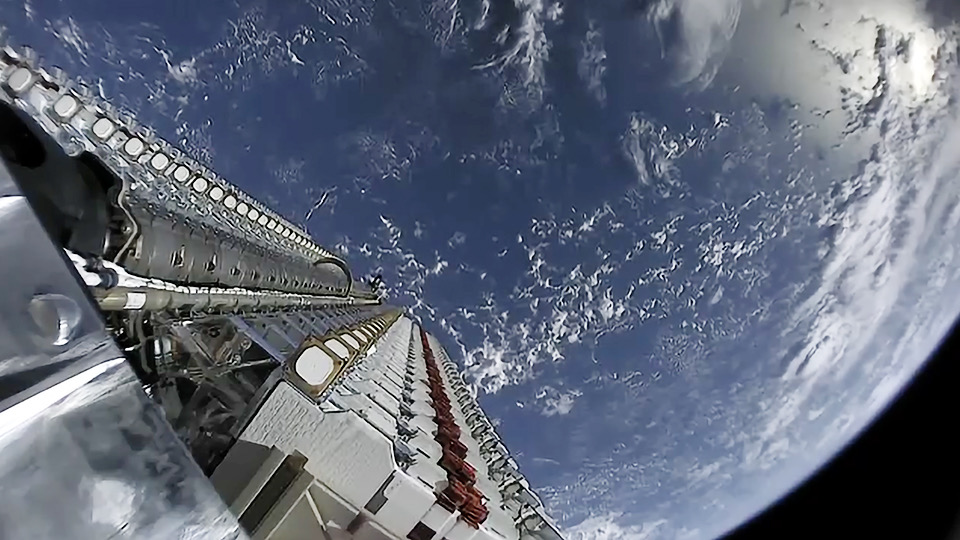
Nearly 3 billion people have never used the Internet, and billionaires Elon Musk and Jeff Bezos have embarked on a mission that could bridge the digital divide.
Through their networks – Starlink and Project Kuiper – the two entrepreneurs are competing to launch thousands of small satellites that will sweep the globe in what is known as low Earth orbit (LEO), connecting places that are too far from terrestrial broadband connections or have been cut off by natural disasters or conflict.
As Bloomberg reported, China and European countries support competing LEO systems for fear of being excluded from important future technology. But setting up in this special part of the atmosphere comes with steep startup costs, complexities, and potentially serious challenges.
Hapag-Lloyd is betting on Elon Musk’s Starlink
The truth through 7 questions and answers
1. How low is LEO?
Most satellites orbit in low Earth orbit at an altitude ranging between 500 km and 2,000 km above the surface of the planet so that they can send data to Earth faster than traditional communications satellites, which are about 36,000 km away. These high-orbit systems have a signal delay of about 600 milliseconds, which is too slow for technologies like live streaming and self-driving cars. Starlink and such satellites hope to be able to compete with the fastest terrestrial networks.
2. Why does Starlink need so many satellites?
Satellites closer to Earth see a smaller portion of its surface, so more of them are needed. Also, the speed that an object needs to maintain a stable orbit increases at lower altitudes, so the satellite must travel at a speed of about 27,000 km/hour to remain aloft, and orbit around the planet within 90 to 120 minutes. Since each satellite is briefly in contact with a ground transmitter, another must appear on the horizon before the first one disappears from view.
3. How will Starlink and its competitors make money?
Selling its services to consumers, governments, businesses operating in remote areas, and 5G fixed and wireless terrestrial broadband providers who need to fill gaps in their own networks. Starlink has also attracted interest from customers in the military sector. The use of Starlink in Ukraine sparked controversy after it emerged that Musk had rejected a request from the country’s government to expand Starlink coverage to Russia-controlled Crimea to aid in a naval drone strike on Russian targets in 2022. Musk had written on the social platform Network X that “Starlink should be a political network.”
4. Can anyone get Starlink?
It is available in an increasing number of countries and at different prices. The Starlink package costs $120 per month in New York, $90 in Alaska, and $92 in the UK, excluding materials and delivery fees.
5. What prompted the LEO invasion?
Technological advances have led to lower launch costs and increased demand for connectivity in remote locations. Previous projects such as Iridium, Globalstar and Orbcomm went bankrupt. Today’s “players” are becoming more viable as the cost of launching satellites declines with the advent of lighter, reusable rockets. Musk’s Falcon 9 can launch a satellite at a cost of $2,600 per kilogram, compared to about $10,000 two decades ago. SpaceX has estimated that the cost of installing Starlink could reach $30 billion, and Musk has said annual revenue could eventually reach $50 billion, helping fund his ultimate ambition — colonizing Mars.
6. Are Starlink’s competitors catching up?
In April 2022, Amazon.com Inc. Bezos closed the largest launch deal ever, sending more than 3,000 satellites to his network. China is building a constellation, and Europe’s leading satellite and space companies have teamed up to bid for the EU-led 6 billion euro ($6.4 billion) satellite project known as IRIS². French President Emmanuel Macron said creating a European “batch” of satellites that could compete with Musk is a “matter of sovereignty.” By the end of this decade, there may be more than 100,000 satellites orbiting the Earth.
7. What is the downside?
Because satellites move so quickly, collisions are difficult to predict and can be devastating. A 10cm-long piece of debris traveling in low Earth orbit could contain the energy equivalent of 7kg of TNT, enough to smash a satellite into thousands of pieces. Radar detection systems can only estimate a satellite’s orbit to within a few miles, as solar radiation and atmospheric drag make the orbital paths slightly irregular. There is concern that some collisions could lead to more collisions, creating clouds of debris that would put the most useful low-Earth orbiters out of action for centuries. There are several proposals for removing space junk. But it will cost billions of dollars, and governments can’t decide who will foot the bill.

“Avid problem solver. Extreme social media junkie. Beer buff. Coffee guru. Internet geek. Travel ninja.”





More Stories
In Greece Porsche 911 50th Anniversary – How much does it cost?
PS Plus: With a free Harry Potter game, the new season begins on the service
Sony set to unveil PS5 Pro before holiday season – Playstation